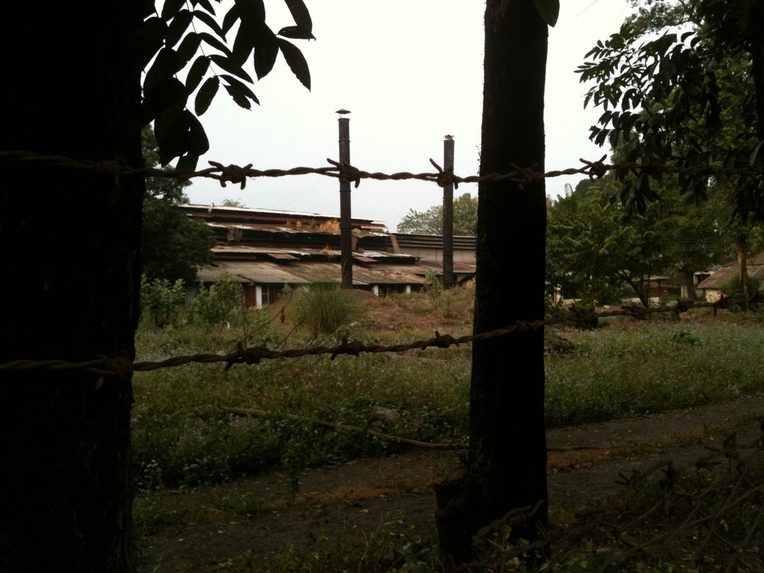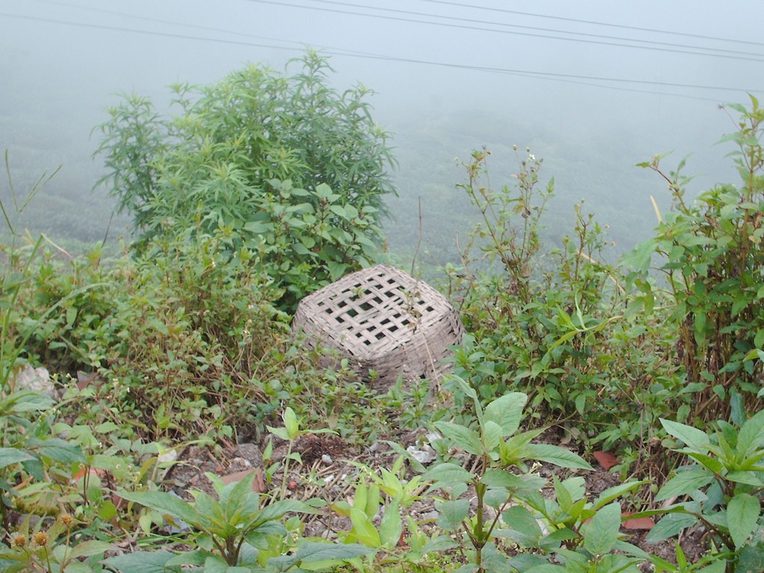Sickness
From the Series: The Naturalization of Work
From the Series: The Naturalization of Work

On a Sunday in January 2016, I was at Stellabarrie Tea Estate in the Dooars, West Bengal. Stellabarrie’s owners had ceased operations and stopped paying wages and benefits to workers the previous September, citing a lack of profitability. Plantation closures have been on the rise in the last decade. These closures are contained almost exclusively to the Dooars, the narrow strip of land that hugs the India–Bhutan border and links India’s Northeast with the rest of the country.
On this Sunday, members of a bankers’ union based in the nearby city of Siliguri were distributing rice to the hundreds of workers who remained on the plantation. The distribution took place at the factory, surrounded by barbed wire and accessible only via a large gate. Workers filed in ten at a time with empty shopping bags, trading pink paper chits for their scoops of rice. A woman at a table inside the gate signed the workers’ chits to prevent them from coming back for more. Outside the factory, a doctor examined workers and distributed medicine. Diagnoses included tuberculosis, low-grade fevers, and common colds. NSAIDs were given out for generalized pain and swelling. Most women were anemic. With some stinging irony, they were told to eat more vegetables and, when they could, a little meat.

Workers to whom I spoke were hopeful that Stellabarrie would reopen by spring. This hope was rooted in past experience. The plantation did tend to reopen after it closed, as it had done several times over the years. The decision by management at Stellabarrie to stop providing wages and benefits in September made sense in the context of the ecology of tea. As the monsoon season reaches its climax, tea bushes still yield leaves, but the value of this “autumn flush” is much less than the “first flush” and “second flush” harvests that occur between March and June. Many plantations follow this pattern, closing in advance of the profit loss on the autumn flush, avoiding the obligation to pay workers a legally mandated holiday bonus during the Hindu festivals in mid-to-late autumn.
Most accounts of plantation closures describe an abandonment of workers by capital. These stories rarely point singular fingers of blame, shifting between state and national regulators, politicians, and plantation owners. In popular media and government discourses, workers are sometimes even portrayed as too lazy to find work elsewhere or as resigned to a life of deprivation and decay.

Workers like those at Stellabarrie who remain on plantations, however, have good reasons to wait. Legally speaking, closed plantations are not completely shut down. They are instead held in suspended animation. Under Indian law, plantation companies can pause production with the objective of getting their finances in order. In both governmental and informal discourse, their plantations are not considered closed, but “sick.” This status is akin to bankruptcy. The state refrains from repossessing the leasehold, and the owner has the opportunity to refinance and reopen. Plantations like Stellabarrie, chronically closed and reopened, were sick in this sense.
It is sickness that allows tea plantations to persist in India, unchallenged, unchanged, despite their association with a colonially rooted, proto-capitalist regime of accumulation. The discourse of sickness naturalizes not just the work of human laborers but also that of the plantation itself. The legal and vernacular category of the sick plantation is, like the aging factories, houses, bungalows, and other features of plantations like Stellabarie, a particular kind of artifact. Just as capitalist ruins can in some cases contain an immanent potential for new relationships of work and value, plantations have a special capacity for endurance and entrenchment (see Tsing 2015). Taken together, plantations are sites and structures through which intimacies among labor, capital, and plants come to seem natural. In times of sickness, the violence of monoculture is intensified, and its more-than-human relational politics rendered more clearly visible.

When I asked plantation owners and managers why sickness was so common, they told me a story of ecological and economic exhaustion. The bushes were old and overworked; the machinery was out of date and in need of repair; the cost of supporting the full-time workforce was too great. The idea that plantations could become sick and potentially recover is a powerful one, not only for owners seeking insulation from state sanction but also for workers. The sick plantation is a category somewhere between the “cheap nature” (see Patel and Moore 2017, 44–63) of a functioning monoculture and the feral state of an abandoned one. A sick plantation is exhausted. It needs rest. What is sick can be healed, if only to eventually fall sick again. In late capitalism, as David Harvey (2000, 106) has argued, sickness has come to be defined as the “inability to go to work.” Here, that which is unable to work is a more-than-human assemblage of hardware, plants, people, and capital. Cycles of plantation sickness are becoming the norm in the Indian tea industry, especially in the Dooars, where plantations specialize in extremely cheap tea destined for the domestic Indian market.
As a treatment for plantation sickness, the food relief at Stellabarie was only temporary—a treatment of symptoms alone. The workers in the food line told me that six kilograms of rice was minimal, but still they took it. “We are old and we can’t do anything else,” one woman explained. “What can I do? I sit in the house and wait.”

Across the Dooars, capital endures because there is always a little more money to be made from those early spring flushes. Labor endures because home is on the plantation. Capital and labor both owe their endurance, in turn, to the tea bushes—old, withered, but after a bit of rest following a bout of sickness, still able to provide enough cheap tea to keep everyone around.
Harvey, David. 2002. Spaces of Hope. Berkeley: University of California Press.
Patel, Raj, and Jason W. Moore. 2017. A History of the World in Seven Cheap Things: A Guide to Capitalism, Nature, and the Future of the Planet. Oakland: University of California Press.
Tsing, Anna. 2015. The Mushroom at the End of the World: On the Possibility of Life in Capitalist Ruins. Princeton, N.J.: Princeton University Press.